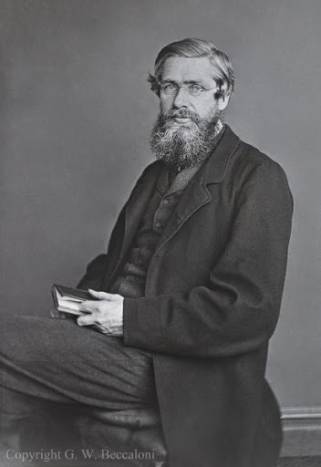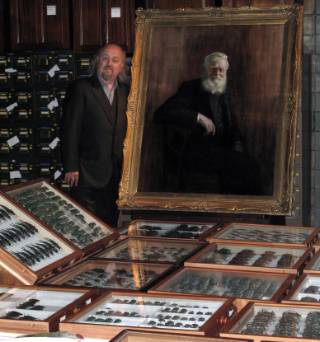The Wallace Memorial Fund has today sent out the Press Release below, appealing for funds for a magnificent and unique life-size bronze statue to commemorate the 100th anniversary next year of Wallace's death (7 November 2013). You can help the campaign in various ways e.g. by posting the text and images below on relevant websites and blogs, or telling potential donors about the campaign. Your help (in whatever way) would be very much appreciated. Wouldn't it be great to see the statue and think that you helped to make it a reality!
Discoverer of Natural Selection to finally get his statue (albeit 100 years late)
Statue of Alfred Russel Wallace to be commissioned for the Natural History Museum, 100 years after the project was scuppered by the First World War.
Alfred Russel Wallace was one of the greatest scientists of the nineteenth century and when he passed away aged 90 in November 1913 plans were soon underway to commemorate his remarkable life. Fundraising began for a statue to be displayed at the Natural History Museum in London, but within a few months this was scuppered by the outbreak of the First World War and the project had to be abandoned.
One-hundred years on, the Wallace Memorial Fund has been revived and is attempting to raise £50,000 GBP to commission a life-sized bronze statue which it will donate to the Natural History Museum. It would be unveiled on 7th November 2013, to commemorate the centenary of Wallace's death. The piece would be sculpted by Anthony Smith; a zoology graduate-turned sculptor, who in 2009 created an acclaimed statue of Charles Darwin for Cambridge University.
The Wallace Fund has already received a generous donation of £10,000 GBP, but it needs to raise the remaining £40,000 GBP in just four months, in order to give the sculptor enough time to produce the work for the November 2013 unveiling.
British comedian Bill Bailey, the Wallace Memorial Fund's Patron, who is a long-time admirer of Wallace, appealed to everyone who loves natural history and science for donations. “Wallace was a maverick genius who deserves much greater recognition for his brilliant discoveries.” He continues, “The statue will be seen by many of the 4.5 million people who visit the museum each year and it will help raise awareness of this extraordinary man.”
Bill at the Natural History Museum, London, with a painting of Wallace and some of Wallace’s specimens.
© Janet Beccaloni
The Natural History Museum is planning a big celebration of Wallace’s life and scientific legacy called Wallace100 which will be launched in January 2013. Wallace100 will culminate with the unveiling of the statue in November. Many other museums and other organisations worldwide are also planning Wallace events; with conferences in London, New York, Mexico, Gibraltar and Sarawak, Malaysia; museum exhibitions in London, Oxford, Wales, the Netherlands, Singapore and Australia; plus several books; and at least one TV documentary.
For more information about the statue, including details of how to donate, visit the Wallace Fund's website.
About Wallace:
 Alfred Russel Wallace in c. 1869 aged c. 46
Alfred Russel Wallace in c. 1869 aged c. 46
© G. W. Beccaloni
Alfred Russel Wallace (1823 - 1913) was one of the 19th century's most remarkable intellectuals. Not only did he co-discover the process of evolution by natural selection with Charles Darwin in 1858, but he also made very many other significant contributions, not just to biology, but also to subjects as diverse as glaciology, land reform, anthropology, ethnography, epidemiology, and astrobiology.
His pioneering work on evolutionary biogeography (the study of how plants and animals are distributed) led to him becoming recognised as that subject’s ‘father’. Beyond this, Wallace is regarded as the pre-eminent collector and field biologist of tropical regions of the 19th century, and his book The Malay Archipelago (which was Joseph Conrad’s favourite bedside reading) is one of the most celebrated travel writings of that century and has never been out of print.
The bulk of his remarkable collection of more than 120,000 specimens of insects, birds and other animals which he made in South-East Asia between 1854 and 1862, including over 5,000 species which were new to science, is cared for by the Natural History Museum. Hundreds of animal species have been named after him, including the spectacular bird-of-paradise Wallace's Standardwing from the Maluku Islands, Indonesia, and the recently discovered gremlin-like Wallace’s tarsier from Sulawesi Island, Indonesia.
Whilst Darwin came from a very wealthy background, Wallace struggled to support his passion for natural history and had to fund his tropical expeditions by selling specimens to collectors back home (Darwin included).
By the time of his death Wallace was probably the world’s most famous scientist, but since then his intellectual legacy has been overshadowed by that of Darwin (who, of course, already has a statue at the Natural History Museum).
END
For more information please contact Dr George Beccaloni, Chairman of the Wallace Memorial Fund (Email: blaberus1@ntlworld.com or g.beccaloni@nhm.ac.uk).



